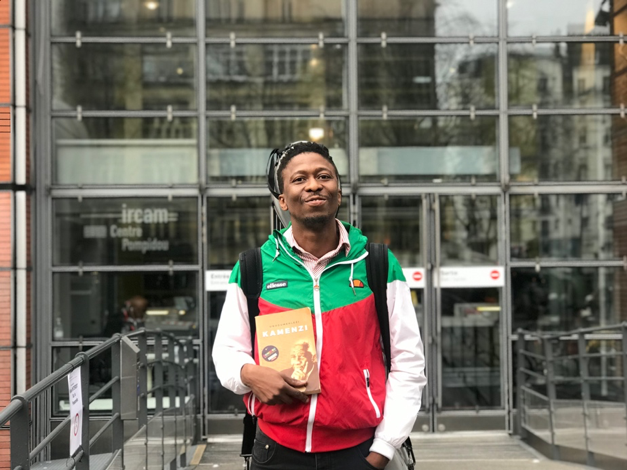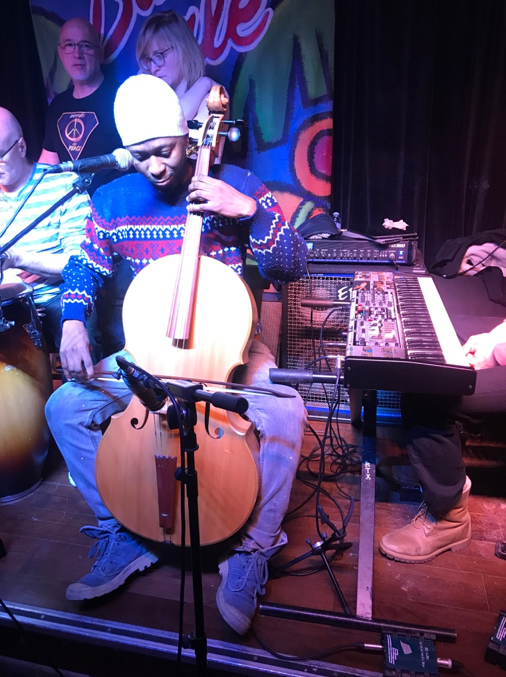Playing with Jazz in Paris by Thokozani Mhlambi

I arrived in Paris on the 8th of January 2020, on a rather cold windy day morning. Packing my luggage into the uber, and with my cello on my side, I then proceeded en route to the 4th arrondissement (district) in Paris, to Cité International Des Arts, an artistic centre located across the road from the Seine River, and overlooking the Notre Dame cathedral. Driving there I saw many Christmas trees which were still erect, some which were now left to rot on corners, as the holiday season was coming to an end.
Many artists from all over the world, who are doing work in Paris come to Cité International des Arts; a place which includes practice studios, a performance auditorium and exhibition centre. It is really a home for artists to meet, interact and collaborate in interesting projects. Having arrived, I signed-in and checked into my studio which is on the 5th floor. Walking those hallways as a musician fills you with a sense of awe as all you hear are different sounds of instruments and voices—practicing scales, etudes, and other material according to their respective disciplines.
With the constant hum of musical instruments, I did not hold back, I got into my instrument and started to practice and play from day one. The first program on my visit was a workshop held at IRCAM—which is the French academic research institute for music science and electronic composition. The centre was founded in the 1960s by classical music maverick Pierre Boulez, the great French composer. Boulez was a great thinker and innovator in the arts. Having a chance to participate in his vision and seeing the scientific innovation process was a great opportunity for me. I had to collaborate with electronic composers, who had produced synthesized sounds from the unique computer software they created.

Mhlambi outside IRCAM academic institute for electroacoustic sound research. Photo courtesy of Thokozani Mhlambi.
From there I went to discover all the jazz cafes and restaurants across the city, particularly those around the Chatelet area.
Jazz arrived in Paris in the 1920s brought by African-American army musicians and the likes of Louis Armstrong. It instantly became a part of the city. Parisian jazz clubs became the places where novelists, painters and musicians from all over the world would meet and talk about creativity, politics, etc. But its real heyday was after World War 2. Here many African-American soldiers and artists found a liberal environment in which they could escape the racist atmosphere in the USA at the time. This is not to say that France itself was not racist, but post-war France evoked a particular atmosphere which tended to elevate the question of freedom. One can sense this in the writings of Jean-Paul Sartre, for example in L'Être et le néant (1943, ‘Being & Nothingness’) and Questions de Méthode (1957, ‘Search for a Method’)—a testament to society which was beginning to question a lot of things about human freedom, following the destructive forces of Nazism and the containment of human mobility, that the state of war evoked on all its victims.
A lot has changed in today’s Paris—I suspect it is a lot cleaner than in those days. Paris has also become an expensive city, especially its central parts, which are economically out-of-reach for most artists and creative practitioners who then have to seek shelter in the suburbs and surrounding towns.
Sitting in these venues for me, brought to mind James Baldwin, Richard Wright and many other artists who had their ‘awakening’ on the streets of Paris. It also brought to mind that great conference of 1956, the ‘Negro-African Writers and Artists Conference’ (Le Congrès des Écrivains et Artistes Noirs), which was incredibly influential in shaping pan-African creativity and scholarship for the next decades. While attending the conference, Baldwin observed Leopold Senghor’s presentation on the role of art/creativity in West African cultures. Here is how he reflected on it:
The only thing in Western life which seemed even faintly to approximate Senghor’s intense sketch of the creative interdependence, the active, the actual, joyful intercourse obtaining among African artists and what only a Westerner would call their public, was the atmosphere sometimes created among jazz musicians and their fans during, say, a jam session (Baldwin 1954).
I, too, was privileged to have my first performance in Paris at one of those jazz jam sessions. I played at the renowned jazz club, Le Baiser Salé . An intimate venue established by three Caribbean brothers in 1983, a year before I was born, it is situated on the famous street of jazz clubs, Rue des Lombards; a long walkway of bars and cafes, with little street food joints selling crepes and North African cuisine. In my playing and singing, I was accompanied by an ensemble of sensitive Paris musicians willing to shoulder me in my procession, as I walked, through my imagination, the ancient paths along the Ulundi mountains. The musicians held my hand as we descended into the KwaZulu dance arenas, heeding the call of the festival horns.

Mhlambi performing with Jazz Ensemble at Le Baiser Sale jazz club, Paris. Photo courtesy of Thokozani Mhlambi.
Part of my intention in coming to Paris was to use the time to connect with artists and intellectuals from different parts of the African continent. Contrary to popular belief, given the size of the African continent, South Africa is actually very far from many destinations on the continent, especially those in the northern parts. This makes it very hard to meet and interact with artists and intellectuals from those countries. In Paris there are a lot of people from all over the world who have come here for economic opportunities. The music scene reflects this diversity. There is obviously the traditional music scene of operas and concert-halls, which is well established and known; but also there is a big world music scene, bringing-in Kora players from Mali, players of Oud, an Islamic classical instrument which is very popular in Morocco, Iran and other Arabic-speaking countries, and Brazilian musicians who bring in the Bossa Nova sounds in the cafes and restaurants of Paris—which come alive every night with all these sounds.

Mhlambi (left) with some of the delegates at the Anglo-Afrique Festival, 21 February 2020. Photo courtesy of Thokozani Mhlambi.
I was invited to contribute to the Anglo-Afrique Festival; a festival held at a conference centre just outside Paris on the 21st of February 2020. It involved diplomats, distinguished guests and performers from many Anglophone countries in Africa. As the sole representative of South Africa at the gathering, I opened my presentation by invoking the legacy of Kwame Nkrumah who had a vision of uniting African nations from the 1940s already, and that of Nelson Mandela, who became the first president of the last country in the continent to receive it’s liberation. From there I was able to play my music and sing in Zulu—something which was appreciated by the Afrocentric audience, who were adorned in all kinds of beautiful colours, fabrics—a demonstration of the linguistic and cultural diversity of Africa. The delegation from South Sudan celebrated the promising prospects of peace, with the President Salva Kiir appointing opponent leader Riek Machar as vice-president.1 An occasion was seen as a “new chapter” in terms of stability in the region.
These are just some of the opportunities the trip to Paris has offered. I am grateful to my supporting partners, the Institut Francais, without whom such a research & development tour would not have been possible. I also wish to convey gratitude to the South African Embassy in Paris, who publicised my endeavours in their newsletter and who have been supportive through the great human evolution that is currently underway.
1 https://www.nytimes.com/2020/02/22/world/africa/south-sudan-kiir-machar.html